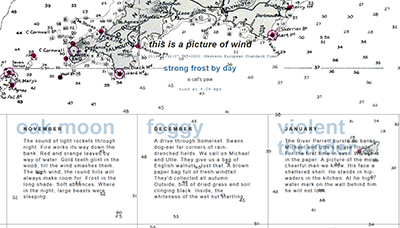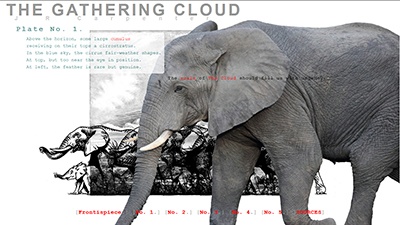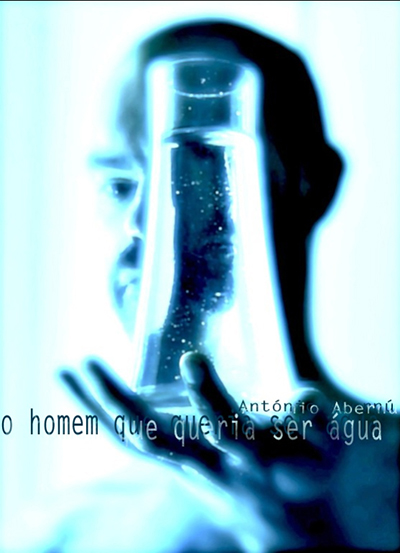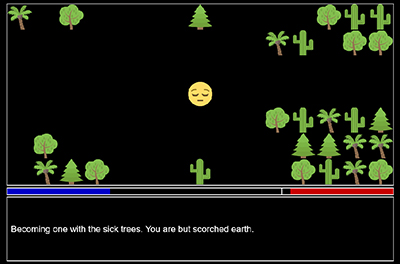Greening the Digital Muse: An Ecocritical Examination of Contemporary Digital Art and Literature

By now, Cultural Ecology, Ecocriticism, and Environmental Humanities can tell us all we need to know about climate change. What's still needed, however, is for authors and artists to reconceptualize environmental issues as social and human questions rather than mere technical ones.
1.
The growing popularity of the term ‘Anthropocene’ – describing a new epoch of profound impact of humans on geological, biotic and climate planetary processes – points out a relevant shift in how we understand the intersection of human culture and environment that is reshaping the world as we know it. Despite the existence of other contenders to signal the end of the Holocene (Capitalocene; Plantationocene; Sustainocene; Cthulucene…) and the discussion about the validity of the concept to characterize the high complexity and the multiple dimensionality of this impact on Earth’s natural systems, ‘Anthropocene’ remains useful to raise awareness of the ever-increasing environmental degradation and to discuss the profound philosophical, social, economic and political implications. If we have difficulty thinking and representing the Anthropocene and what it stands for, it is probably because we lack the knowledge to understand the densely distributed and temporally widespread “hyperobjects” of geology, to use Timothy Morton’s concept (Morton 2013). It is a useful way into thinking about those climatic, geological, economic and technological entities of such an extent that they exceed human comprehension. For Morton, global warming is the prototypical hyperobject: it is extremely large in comparison to a vast group of other objects contained within it and impossible to point to, except by way of abstraction or indicia. The complex phenomenon of global warming or the considerable lapse of time between causes and the perceptible effects of toxification processes, among several other examples, elude identification.
In response to these conditions and questions, we have seen the emergence and dynamic unfolding of new and overlapping transdisciplinary fields or critical methodologies (e.g. Cultural Ecology, Ecocriticism, and Environmental Humanities). Interdisciplinary and plural, combining a large array of multifaceted scholarly approaches (Rose et. al. 2012; Oppermann 2011; Gersdorf and Mayer 2006), the field has however a focal point: the need to reconceptualize environmental issues as social and human questions rather than mere technical ones, to be handled by experts or technocratic structures.
Engaging with these ongoing critical discussions, this paper offers an eco-oriented reading of literary and artistic digital works. How do the contemporary digital art and electronic literature contribute to the discussion of planetary-scale issues of ecological transformation and disaster? How do they consider or reconsider the human in its relationship with non-human others? And what hope is there for counter-hegemonic discourses to challenge current unsustainable societal and economic practices?
2.
There is a wide acknowledgement that human actions and decisions are driving far-reaching transformations to the life-supporting infrastructure of the Earth, causing an increase of severe winter storms and other extreme weather and climate events. Roderick Coover and Scott Rettberg’s combinatory narrative film Toxi•City: a Climate Change Narrative calls attention precisely to the fragility of human life against watery flooding, industrial pollution and chemical exposure. Set in urban and post-industrial areas fustigated by violent storms, repeated flooding and sea-level rise, the narrative imagines a near future in which the densely populated areas are affected by toxins and chemical waste from the industrial sites. For the six main fictional characters, the widespread contamination has become the foregrounded condition of everyday life rather than an exceptional and contained event. All of testimonies reflect some aspect of the post-catastrophic environment, but none of them provides a large and comprehensive view of the situation.

Some of the most powerful signifiers of industrialization and capitalism – oil refineries, steel industries, shipbuilding and other heavy industries – and thus of human achievement became a civilization fall and climate tragedy. The project takes up what we know already about the industrial pollution along the Delaware River or the dramatic effects of the 2012 Hurricane Sandy and brings that experience into relation with catastrophic scenarios yet to come. It assumedly intertwines fact and fiction by using visual material of the Delaware River and true stories of deaths from recent storms and hurricanes in that same area. For many reasons, Sandy was a wake-up call in the United States, but in both private and public spaces of knowledge and discussion a division soon became apparent: on the one hand, the recognition of a strong link between such a climate disaster and the global warming and, on the other, the denial of such a causality.
Based on the permutation of a limited number of elements in a database according to a syntactic matrix, the combinatory algorithm creates the illusion of being unlimited when, in fact, it exhausts the possibilities of transformation to the end of a given number of iterations. According to Rettberg, the work has four different beginnings and each of them “offers a different character’s exposition on the events of the fictional narrative”. On the other hand, humans are almost exclusively represented “as voices rather than as embodied actors seen on screen” (Rettberg 2016: 12). Regardless of other practical reasons, this option has important aesthetic implications, since without a face (and a body) visible it is possible to improve the degree of identification and empathy with the circumstances.
Over the last years, other projects arose as a result of close collaboration between the filmmaker and the fiction writer, but always with one important feature in common: to deal with challenges and problems faced by contemporary society. This can be exemplified by a set of films – The Last Volcano, Cats and Rats and Norwegian Tsunami – presented as a trilogy: The Catastrophe Trilogy. These films were created to re-visit long ago events – a deadly volcanic eruption, a massive floods and the plague – in light of contemporary questions and crisis, namely recent and impressive volcanic eruptions in Europe, lethal viruses and deep drilling in the North Sea.
These specific projects embrace uncertainty as a way of thinking that encourages active engagement in creating a desirable future. One might say that attempts to deal with and creatively express the idea of collapse are increasing and becoming more widespread (Kaplan 2016; Vogelaar 2018). In the past, humankind has expressed its preoccupations with a stable world through collapse and disaster imaginaries, but now environmental collapse has become a way of framing and imagining climate change. Discourses of the end are not exclusive to our own time and cultural moment; in fact, contemporary manifestations of collapse are deeply rooted in earlier traditions, from apocalypse to dystopia.
Considering how climate change itself might be understood as traumatically affecting readers and viewers is a major point in this discussion. For E. Ann Kaplan, the representation of catastrophic futurist scenarios, namely in dystopian films and novels, could lead to a “pretraumatic stress syndrome”. In many cases, “audiences are invited to identify with future selves in uncertain, dangerous, and ultimately unsustainable worlds. Such identifications result in a pretraumatized population, living with a sense of an uncertain future and an unreliable natural environment” (Kaplan 2016: XIX). Uncertainty about the future may not be avoidable, but the way we conceive such uncertainty, maintaining dystopic or apocalyptic scenarios, can undermine effective action more than stimulate it. If anxious discourse overshadows productive approaches, the problem of alienation will be further complicated.
3.
Each one of the case studies presented in this paper offers, in its own way, a unique response to the challenges of representing climate change. They reveal not only a world under environmental crisis but also investigate how we can and cannot see this world or how the technological mediations help to shape the human understanding of it. Converting, however, global climate change data into sensory and affective experiences with aesthetic value, without losing its effectiveness in raising public awareness, has proven to be a much more difficult task. We are dealing now with highly complex scenarios which require suitable frames of reference and stable descriptions, in a permanent state of tension between analytic models and data. Even the perception of landscape around us is influenced and mediated by complex visualizations, large climate datasets or even predictive models.
Despite all technical advancements made until now, our climate knowledge is provisional and imperfect, but the enthusiasm for it persists in many forms of artistic expression and invention. One fine example of this enchantment with natural phenomena can be seen in the work of J. R. Carpenter. In The Gathering Cloud and This is a Picture of Wind, one can recognize a long tradition of intellectual fascination with the ontological vagueness of clouds and the struggles to apprehend the complexity of wind speed variations and storm effects. In the first case, it is a hybrid print- and web-based work which directly addresses the environmental impact of cloud computing and bridges the gap between science and literature. We sense and produce the environment through the materiality of language, but being able to re-visit the detailed observations collected decades or even centuries ago guarantees a new perspective of the laborious knowledge construction process. One of the most compelling features of Carpenter’s works is the ability to deal with that wide range of discourses and practices related to weather phenomena, the dynamics of atmosphere and the history of meteorology (from Aristotle’s treatise Meteorologica to Luke Howard’s Essay on the Modifications of Clouds and others). The work highlights the difficulty, throughout history, to put into words such volatile natural phenomena as wind and atmospheric circulation. On the other hand, the collection of literary expressions of wind speeds is directly connected to a live data feed, reinforcing the perception of different modulations in real time.

Carpenter’s The Gathering Cloud seems to mark the point of intersection of contemporary critical approaches to media culture and the environmental. Although vastly disseminated in the public imagination, the idea of the ‘cloud’ of online data storage as neutral and smooth is far from being environmentally friendly. As Carpenter writes: “The scale of The Cloud should fill us with urgency” and the real consequences of the supposedly cloudiness of ‘cloud computing’: “The Cloud is just someone else’s computer, that’s what the coffee mugs and fridge magnets say. But what does that mean? How much does The Cloud weigh?” (Carpenter 2017). As pointed out by Jussi Parikka in the prologue to the printed edition of this work, “the current informational culture [is] one of light, marked by the weightlessness of fiber optics and the speed of digital transactions”, and yet “it is also one of weight – of minerals, metals, energy consumption, and entropy” (Parikka 2017: 9). The absence of hardware storage and processing power on the user’s computer or other devices and the illusory immateriality of the infrastructure of data centers create a double feeling of smoothness. Behind this global-scale virtualization process, as Carpenter’s work points out, lies: “an estimated 1.8 trillion gigabytes of digital information […] created and stored globally each year by ordinary consumers with no sense that data is physical and storing it has a direct impact on the environment”. One of the main objectives of the recently published The Metainterface: The Art of Platforms, Cities and Clouds (Andersen and Pold 2018), is precisely to understand how art explores these technological advances of the new metainterface, a powerful contemporary paradigm that evades perception and has become increasingly global and pervasive.

4.
Water issues have become one of the most ecologically instigating questions of the twenty-first century. Artists and writers are paying attention to water, its movements and relations, what it does, and how it shapes itself and other bodies. Water already permeates our concepts and theories, as we can see from the popularity of ‘flow’ and ‘fluidity’ in contemporary Western culture. Water is the ground substance of all life and all forms of life project various structural patterns of water. Our bodies are, in fact, constantly transformed through water and connected to other bodies of water (Neimanis 2017).
To think water through different artistic perspectives is the main purpose of António Abernú in his multidimensional project entitled The man who wanted to be water, but especially in the hypermedia @guaA_ digital story, enabling critical reflection and aesthetic fruition. For him, water is much more than just a physical substance; it is a multifaceted entity. Like so many other artists, scientists and people who have spent large amounts of time in water research, Abernú is obsessed with the ontological complexity of water. As we learn more about this subject, it becomes clear that there are several hidden properties that we don’t fully understand. In fact, the aim is to reveal the various aspects of our complex relationship with water, providing an account of its symbolic and philosophical significance. This involves looking at how water has been understood and the role it has played: “The ontology of water has to do with the time evolution, contamination, mixing, fusion of materials and permanent recoding memories. The water is transformation, metamorphosis, formal regeneration, articulation of life and death.” (Abernú 2013).
 Figure 4: © António Abernú. O homem que queria ser água [The man who wanted to be water]
The artwork is built upon contributions from a number of Western philosophers who advocate the sentient nature of water: T. Schwenk, the first to document its hidden attributes, particularly the relationship of water’s rhythms and movements seen in its flows, and to those found in the organic world; Jacques Benveniste; Philip Ball; and Masaru Emoto’s experiments with frozen crystals of water and other sources of vibration, especially sound and thought, which could affect the structure of water.
Figure 4: © António Abernú. O homem que queria ser água [The man who wanted to be water]
The artwork is built upon contributions from a number of Western philosophers who advocate the sentient nature of water: T. Schwenk, the first to document its hidden attributes, particularly the relationship of water’s rhythms and movements seen in its flows, and to those found in the organic world; Jacques Benveniste; Philip Ball; and Masaru Emoto’s experiments with frozen crystals of water and other sources of vibration, especially sound and thought, which could affect the structure of water.
But, a special mention must be made of the presence of alchemy in @gua. The work tells the story of Water and his journey through the four basic elements: air, water, land and eventually dying by a union with fire previous to the rebirth: “with a mixture of joy and fear, he [WATER, the character] remembered a line he had read once in a very old book of alchemy: the philosophical putrefaction consists in the corruption or destruction of bodies; once a form is destroyed, nature soon brings another one in its place, better and more subtle at the same time” (Abernú 2013). Here the author alludes to one of the four alchemical stages, the nigredo. At the center of alchemical reasoning, we can found the unity of nature (or prima materia) from which all bodies were formed and into which they might again be dissolved and the existence of a transmuting agent, the philosopher’s stone capable of promoting the change of one kind of material into another. It is worth noting that alchemy “represents a cultural practice before the Cartesian split between subject and object, mind and body, god above and inert matter, was generally accepted. It contains representation of nature, plants, animals and landscapes, as essential aspects of becoming human” (Rowland 2005: 105).
5.
Several writers and artists suggest the urgency of re-imagining the relationships between humans and other beings. Contrary to the image of the human as self-sufficient and sovereign, an increasing number of conceptualizations reveal the interconnected relationships between humans and non-humans natures. The non-human other has been an inspiration for metaphysical speculation, ontological inquiry, and aesthetic activity for a long time. Nevertheless, there is now a growing sense of urgency to the scrutiny of empirical and conceptual relations between human and other-than human entities and worlds. They demand refreshed attention and evoke newly vital forms of meaning given our context of catastrophic, anthropogenic environmental change on a planetary scale. So, how can we consider or reconsider the human in its relationship with non-human others?
Thinking about an alternative paradigm that might engage us in response to the Anthropocene, Donna Haraway emphasizes the ontologies of being with, as and through environments, where nature cannot be separated from culture:
What happens when human exceptionalism and the utilitarian individualism of classical political economics become unthinkable in the best sciences across the disciplines and interdisciplines? Seriously unthinkable: not available to think with. Why is it that the epochal name of the Anthropos imposed itself at just the time when understandings and knowledge practices about and within symbiogenesis and sympoietics are wildly and wonderfully available and generative in all the humusities, including noncolonizing arts, sciences, and politics? (Haraway 2016: 57)
Understanding the coexistence of human and non-human beings as a mutual relationship instead of considering the non-human merely on utilitarian grounds is one of the major premises of Eugenio Tisselli’s The Gate (2017). One easily recognizes his engagement with a non-hierarchical representation of natural and human beings, revealing our bodies as being part of the natural world and not disconnected from it: “The Gate invites players to immerse themselves in a dying, overheated forest in which the only hope for survival lies in their ability to learn the languages spoken by animals and other creatures” (Tisselli 2017). With ludic inventiveness, Tisselli helps us along in the unthinking of anthropocentrism and emphasizes an ethics of the encounter that encourages more sensitivity to alternative (more-than-human) time scales and environmental futures: “When the ongoingness of life on Earth is threatened by climate disruption and ecological collapse, new forms of engagement with non-human beings become a matter of life or death.” (Tisselli 2017)

The oversimplified idea that humans are all equally responsible for climate change, instead of acknowledging different degrees of blame, is one of the most powerful objections made to ‘Anthropocene’ as a concept. The driving forces behind the hegemonic conceptualization of ‘global warming’ or ‘climate change’ are deeply connected with European or North American contexts. They play a major role in determining how to identify who is responsible for it, who is most affected or how the recommended solutions could be implemented. In fact, the persistent use of generalization strategies (“humankind”, “we”) eludes relevant distinctions and it is a way to get out of responsibility for addressing the reasons why climate change is occurring. It is easy to recognize that the experiences of Indigenous people and low-income people don’t get the same level of attention, although they are some of the most severely affected by climate change (Nixon 2011; Ray 2013). Tisselli had already addressed some of the drastic consequences of the physical materiality of our contemporary media culture, employing critical thinking to reveal fallacies and confront capitalism’s hegemony (Tisselli 2018). At a time of environmental change and anxiety, one that results largely out of forms of seeing and knowing that transform other-than-human entities into mere things, artworks draw deeply from animism as a vital realm of meaning and as a practice of imaginative resistance to an objectifying relation with and understanding of the world. In truth, most Indigenous cultures are guided by principles of respect and responsibility, while coexisting with all other beings (Adamson and Monani 2016).
6.
As works of media art and electronic literature, their techniques and modes of expression vary, but the ability to address contemporary problems is unquestionable. In the multiform situations conjured in these works, there are deep resonances with emergent and incisive forms of ecological thinking. They demonstrate the proposition that artists and writers remain fundamental “seeing instruments” (Adamson 2001, 145), promoting a perception of and attentiveness to the connections of the human with the other-than-human. The aspirations of contemporary artists to reveal an understanding of environmental conditions that will bring out an impulse to modify the effects of climate change situates these artistic genres within an established tradition of merging aesthetic appreciation of nature with a concern for its conservation. In sum, a wide array of artistic features made possible by technological advances opens up new horizons to problematize and question the boundaries between the creator, the artistic/literary object and their material and social environments.
REFERENCES
Abernú, António. O homem que queria ser água [The man who wanted to be water], 2013. <http://collection.eliterature.org/3/work.html?work=agua-um-conto-digital>
Adamson, Joni. American Indian Literature, Environmental Justice, and Ecocriticism: The Middle Place. Tucson: University of Arizona Press, 2001.
Adamson, Joni and Salma Monani. Ecocriticism and Indigenous Studies: Conversations from Earth to Cosmos. New York: Routledge, 2016.
Andersen, Christian Ulrik and Søren Bro Pold. The Metainterface: The Art of Platforms, Cities, and Clouds. Cambridge, MA: The MIT Press, 2018.
Carpenter, J. R. The Gathering Cloud. Devon: Uniform Books, 2017. <http://luckysoap.com/thegatheringcloud/>
―. This is a Picture of Wind. IOTA: DATA, 2018. <http://luckysoap.com/apictureofwind/>
Chen, C., J. MacLeod, J. and A. Neimanis. Thinking with Water. Montreal: McGill-Queen’s University Press, 2013.
Coover, Roderick, and Scott Rettberg. Toxi•City: A Climate Change Narrative. CR Change Production, 2014. <http://crchange.net/toxicity>
Emoto, Masuru. Messages from Water. Tokyo: Hado Kyoikusha, 2004.
Emoto, Masaru. The Hidden Messages in Water. Hillsboro, Ore.: Beyond Words Publishing, 2004.
Gersdorf, Catrin and Sylvia Mayer (eds.). Nature in Literary and Cultural Studies: Transatlantic Conversations on Ecocriticism. Amsterdam and New York: Rodopi, 2006.
Haraway, Donna J. When Species Meet. Minneapolis, MN: Minnesota University Press, 2008.
―. Staying with the Trouble. Making Kin in the Chthulucene. Durham and London: Duke University Press, 2016.
Kaplan, Ann E. Climate Trauma: Foreseeing the Future in Dystopian Film and Fiction. New Brunswick, NJ: Rutgers University Press, 2016.
Morton, Timothy. Ecology without Nature: Rethinking Environmental Aesthetics. Cambridge, MA: Harvard University Press, 2007.
―. Hyperobjects: Philosophy and Ecology after the End of the World. Minneapolis: University of Minnesota Press, 2013.
Neimanis, Astrida. Bodies of Water: Posthuman Feminist Phenomenology. London: Bloomsbury Academic, 2017.
Nixon, Rob. Slow Violence and the Environmentalism of the Poor. Cambridge, MA: Harvard University Press, 2011.
Oppermann, Serpil. “Ecocriticism’s Theoretical Discontents” Mosaic 44(2), 2011, pp. 153-169.
Parikka, Jussi. “On Media Meteorology”. In The Gathering Cloud. Devon: Uniform Books, 2017, pp. 9-10.
Ray, Sarah. The Ecological Other: Environmental Exclusion in American Culture. Tucson: University of Arizona Press, 2013.
Rettberg, Scott. “AS - Situating Change: Combinatory Writing, Interdisciplinary Collaboration, Technology, and Political Reality”, Miranda [Online], 12, 2016. <http://journals.openedition.org/miranda/8751>
Rose, Deborah Bird et al. “Thinking through the Environment, Unsettling the Humanities.” Environmental Humanities, 2012, 1, pp. 1-5.
Rowland, Susan. Jung as a writer. New York: Routledge, 2005.
Schwenk, Theodor, and Wolfram Schwenk. Water: The Element of Life. New York: Anthroposophic Press, 1999.
Schwenk, Theodor. Sensitive Chaos: The Creation of Flowing Forms in Water and Air. London: Rudolf Steiner Press, 1965.
Tisselli, Eugenio. The Gate. 2017. <http://motorhueso.net/thegate/>; <https://vimeo.com/206718604>
―. “The Heaviness of Light”, MATLIT: Materialities of Literature [Online], 6.2, 2018, pp. 11-25.
Vogelaar, Alison E., Brack W. Hale and Alexandra Peat (Ed.). The Discourses of Environmental Collapse: Imagining the End, New York: Routledge, 2018.
Zalasiewicz, Jan, Mark Williams, and Colin N. Waters. 2015. “Anthropocene.” In Keywords for Environmental Studies, ed. Joni Adamson, William A. Gleason, and David N. Pellow, pp. 14-16. New York: New York University Press.
Cite this article
Silva Pereira, Paulo. "Greening the Digital Muse: An Ecocritical Examination of Contemporary Digital Art and Literature" Electronic Book Review, 3 May 2020, https://doi.org/10.7273/v30n-1a73